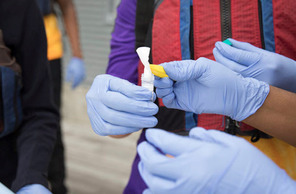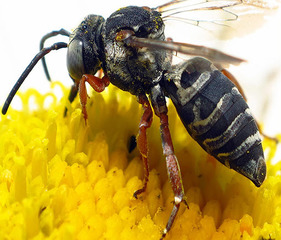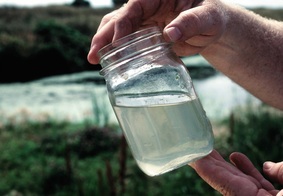|
Having trouble viewing this email? View it as a Web page.

|
|
|
Fresh from the Field is a weekly album showcasing transformative impacts made by grantees supported by the National Institute of Food and Agriculture.
Dec. 14, 2017
|
|
|
Fresh from the Field will be on holiday hiatus
after this issue and return Jan. 11, 2018. We at NIFA wish you the best holiday
season ever.
Success Stories

Improving Food Quality, One Light at a Time
Fort
Valley State University aims to make a mark in food safety research with the
help of a new pulsed ultraviolet (UV) light system that could aid in the
decontamination of foods and extend shelf life without heat or chemical
preservatives. XENON pulsed UV light Z-1000 modular sterilization system is
unique because it’s an extremely safe and sanitary method for rapidly killing
microorganisms on food surfaces.
Pulsed
UV-light is more efficient than continuous UV light, because it offers
better penetration potential through food products. Pulsed UV light can kill up
to 99.9 percent of pathogenic and spoilage microorganisms, molds, parasites,
and insects. It can also kill bacteria on surfaces of food packaging materials.
The light does not affect taste or alter any other properties.
NIFA supports this project through Evans-Allen funding.
Read the full article in FVSU News. Photo courtesy of Fort Valley
State University.
|
 Teen Detectives Use DNA to Stalk Invasive Fish
Once
they infiltrate bodies of water, northern snakeheads are hard to shake. So far,
New York State has had two outbreaks of the unwelcome fish—one that has been
wrestled under control, and one with a much more problematic prognosis.
Through
Cornell’s FishTracker program, teams of life-jacket-clad teenagers lean out
over docks to scoop water samples from the Hudson River and take them back to
the lab, where researchers search for specific DNA signatures. “Every fish in the Great Lakes has been barcoded, just like the
universal product code that you scan in the supermarket,” said James Casey, a
virologist at Cornell University’s College of Veterinary Medicine.
The
FishTracker team of more than 3,000 students from 78 schools have surveyed 320
sites across New York State. They’re currently monitoring for six invasive
species and two endangered ones, the American eel and the deepwater cisco.
Their reporting of a species in a particular location is accurate to within six
hours.
NIFA supports the project through Hatch funding.
Read the full article in the Atlas Obscura. Photo courtesy of Cornell
University.
|
News Coverage

New Discovery, More Bees Mark Michigan’s First
Full Bee Census
The
first complete bee census, led by Michigan State University scientists,
confirmed a new species and revealed that the actual number of bee species in
Michigan exceeded earlier estimates.
Identifying
potential pollinators is crucial, especially in the face of declining honey bee
populations. All pollinators make an estimated $14 billion annual contribution
to U.S. agriculture, so it’s imperative to understand wild bee populations and
their benefits to crops and the environment.
The
monograph is featured in a recent issue of the journal Zootaxa and shows that
the Great Lakes State hosts 465 species of bees – the highest number of species
reported by surrounding states.
NIFA supported the program through the Integrated Crop Pollination Project.
Read the full article in MSU Today. Photo by Jason Gibbs.
|
The Library

Stronger Storms Hamper Ability of Streams and
Rivers to Clean Up Pollution
Freshwater
streams and rivers naturally clean up some forms of pollution originating from
urban and agricultural areas, but increased storm intensity reduces this
ability. This fact underscores the need to improve the management of nonpoint
sources of pollution and storm water management.
Nonpoint
source pollution comes from many sources, such as agricultural land,
construction sites, and residential areas. Heavy rain or snowmelt can
pick up and transport the pollutants to streams, rivers, lakes,
wetlands, coastal waters, and ground waters.
Scientists
from the University of New Hampshire used a new generation of high-technology
sensors, placed directly into streams and rivers, to measure nitrate
concentrations continuously under different flow conditions. These sensors are
transforming the understanding of water quality and how to improve its
management.
Results
of the study will encourage people to think about how much to fertilize lawns and
ensure septic systems are maintained, and help community leaders make decisions
about reducing nutrient inputs.
NIFA supports this project through Hatch funding.
Read the article journal Water Resources Research. NRCS photo.
|
Video
 Rock Salt is Getting into Groundwater and Wells,
Study Finds
Despite
strong winter weather, salt on roadways allows us to get out and drive. But,
according to recent study at Virginia Tech, that could come back to hurt us. The
study found that, despite measures to avoid it, chloride in road salt is getting
to water.
If
salt levels continue to increase in freshwater areas, many fish and amphibians
will stop breeding and eventually die because their bodies cannot adjust to the
change. Water creatures are not the only ones affected by excess chloride,
however.
A
separate study, done by the Flint Water Team in Orleans, New York, found if the
salt gets into common copper pipes that are held together by lead-soldered
joints, the pipes can break down. That means more salt gets into drinking
water, and that is often not good for people with hypertension and other medical
conditions.
NIFA supports this project with an Agriculture and Food Research Initiative
grant.
Watch the news report from WDBJ.
|
Tweet of the Week
#NIFAIMPACTS
|
|

NIFA’s mission is to invest in and advance agricultural research, education, and extension that solve societal challenges. NIFA’s investments in transformative science directly support the long-term prosperity and global preeminence of U.S. agriculture. To learn more about NIFA’s impact on agricultural sciences, visit www.nifa.usda.gov/Impacts, sign up for email updates or follow us on Twitter @USDA_NIFA, #NIFAImpacts.
Editor: Falita Liles
USDA is an equal opportunity lender, provider, and employer.
|
|